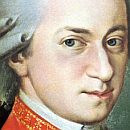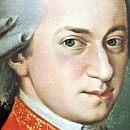
This summer’s festival opens at Mission Santa Clara in about two weeks, July 16 to be exact. San Francisco was offered one of its tempting preview programs last Tuesday as one of the weekly Noontime Concerts in Old St. Mary’s Cathedral. These are well worth attending, only be warned: They don’t begin at exactly noon, but instead at 12:30 p.m., following a noon Mass service.
Two Mozart works were offered: the Piano Trio No. 3 in B-flat Major, K. 502, and the less-impressive Piano Quartet No. 2 in E-flat Major, K. 491. Performers included Mariya Borozina, violin; Caroline Lee, viola; Eric Sung, cello; and, critically, virtuoso pianist Miles Graber. The large audience cheered the performance to the echo, hoping for encores, but none appeared.
The K. 502 Trio comes from a particularly rich patch in Mozart’s output. K. 501 is the yummy Andante and Five Variations for piano four-hands; the grand Piano Concerto No. 25 in C Major makes up K. 503, and the supermasterpiece, the Symphony No. 38 in D Major, called the “Prague,” is K. 504. The B-flat trio is as fine as any of them.
It’s cast in the traditional fast-slow-fast movement order. The first and last boast Mozart’s sunny style, with a central Larghetto set as a kind of profound Romanza. That slow movement reaches the emotional level of the better-known slow movement of his 21st Piano Concerto, which came into full notice only after being used for films such as Elvira Madigan and for several ballets.
The performance was a gold star one in all its parts: perfect style and tempo, beautifully balanced and technically bravura. The players didn’t slobber over the slow movement, either (always a temptation) but kept its elegant momentum moving along, absent any emotive exaggerations. Here was Mozartean classicism at its finest.
When asked to evaluate Mozart’s music, Haydn simply said, “He exceeds me in matters of harmony.” What Haydn was hinting at was the younger composer’s subtle use of dissonance in small portions. (I’ve always suspected that this stemmed from Mozart’s ever-increasing study of Bach’s music.) We hear this in all his greatest compositions, especially in his use of fugal textures. He used dissonance sparingly, to be sure, as a means to pinch the listener’s emotions momentarily, sometimes approaching painful levels (but never exceeding them).
That’s my complaint against the Second Piano Quartet. It’s a perfectly nice piece — in the way that someone uses nice in “He’s a nice guy (or gal),” to mean pleasant but a tad bland. It sounds rather timid when compared to the First Piano Quartet, K. 478, written in Mozart’s surefire key of G minor.
The E-flat Quartet lacks the composer’s momentary delving into advanced harmony. The finale of the three movements possesses great charm in its folksy lilt, but, like the music of Louis Spohr and Anton Rubinstein, the Quartet sounds too driven by surface courtesy. (And after all, Spohr and Rubinstein were each wildly popular in their day.) Perhaps the E-flat Quartet was written for some royal who didn’t want to be bothered with emotional music that would draw his attention away from other things. I don’t know, but maybe.
Lord knows, the performance at Old St. Mary’s was top class, with pianist Graber and violinist Borozina delivering particularly fine playing. That’s vital, since they carry the lion’s share of the important material. For Mozart failed here to use the viola and cello as much more than background support. That’s unusual for him.
Old St. Mary’s continues its Noontime series tonight, July 7, with violinist Joan Nagano and pianist Kay Stern offering an interesting program of neglected major works: the First Sonatas of Grieg and Schumann, plus the Suite from Korngold’s opera Die tote Stadt. Next Tuesday, July 14, it presents a program of high Baroque chamber music on period instruments honoring Bastille Day. It includes music by Couperin, Leclair, Breval, Rameau, and Duport. The 12:30 Noontime series extends through Tuesday, Aug. 25.

